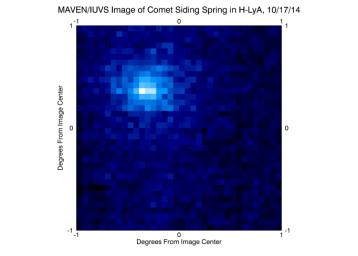
|
MAVEN Ultraviolet Image of Comet Siding Spring’s Hydrogen Coma
- Click the image above for a larger view
- Full-Res JPEG (6256 x 4479) (705.2 kB)
- Full-Res TIFF (6256 x 4479) (84.1 MB)
Caption:
NASA's Mars Atmosphere and Volatile Evolution (MAVEN) spacecraft obtained this ultraviolet image of hydrogen surrounding comet C/2013 A1 Siding Spring on Oct. 17, 2014, two days before the comet's closest approach to Mars. The Imaging Ultraviolet Spectrograph (IUVS) instrument imaged the comet at a distance of 5.3 million miles (8.5 million kilometers).
The image shows sunlight that has been scattered by atomic hydrogen, shown as blue in this false-color representation. Comets are surrounded by a huge cloud of atomic hydrogen because water (H2O) vaporizes from the icy nucleus, and solar ultraviolet light breaks it apart into hydrogen and oxygen. Hydrogen atoms scatter solar ultraviolet light, and it was this light that was imaged by the IUVS. Two observations were combined to create this image, after removing the foreground signal that results from sunlight being scattered from hydrogen surrounding Mars.
The bulk of the scattered sunlight shows a cloud that was about a half degree across on the "sky" background, comparable in size to the Earth's moon as seen from Earth. Hydrogen was detected to as far as 93,000 miles (150,000 kilometers) away from the comet's nucleus. The distance is comparable to the distance of the comet from Mars at its closest approach. Gas from the comet is likely to have hit Mars, and would have done so at a speed of 125,000 miles per hour (56 kilometers per second). This gas may have disturbed the Mars atmosphere
Background Info:
MAVEN is NASA's Mars Atmosphere and Volatile Evolution (MAVEN) spacecraft. NASA Goddard Space Flight Center in Greenbelt, Md., manages the MAVEN project for NASA's Science Mission Directorate, Washington, and built some of the science instruments for the mission. MAVEN's principal investigator is based at the University of Colorado's Laboratory for Atmospheric and Space Physics in Boulder. The university provided science instruments and leads science operations, as well as education and public outreach, for the mission. Lockheed Martin Space Systems, Denver, built and operates the spacecraft. The University of California at Berkeley's Space Sciences Laboratory provided instruments for the mission. JPL, a division of the California Institute of Technology in Pasadena, provides navigation support and Deep Space Network support, NASA's Jet Propulsion Laboratory in Pasadena, California, provides navigation and Deep Space Network support, as well as the Electra telecommunications relay hardware and operations.
For more information about MAVEN, visit http://www.nasa.gov/maven and http://lasp.colorado.edu/home/maven/ . For more information about NASA's Mars Exploration Program, see http://marsprogram.jpl.nasa.gov .
Cataloging Keywords:
| Name | Value | Additional Values |
|---|---|---|
| Target | Mars | C/2013 A1 (Siding Spring) |
| System | ||
| Target Type | Planet | Comet |
| Mission | Mars Atmosphere and Volatile Evolution (MAVEN) | Deep Space Network (DSN) |
| Instrument Host | MAVEN | |
| Host Type | Orbiter | |
| Instrument | Imaging Ultraviolet Spectrograph (IUVS) | |
| Detector | ||
| Extra Keywords | Atmosphere, Color, Radio, Ultraviolet, Water | |
| Acquisition Date | ||
| Release Date | 2014-10-23 | |
| Date in Caption | 2014-10-17 | |
| Image Credit | NASA/Laboratory for Atmospheric and Space Physics/Univ. of Colorado | |
| Source | photojournal.jpl.nasa.gov/catalog/PIA18619 | |
| Identifier | PIA18619 | |
